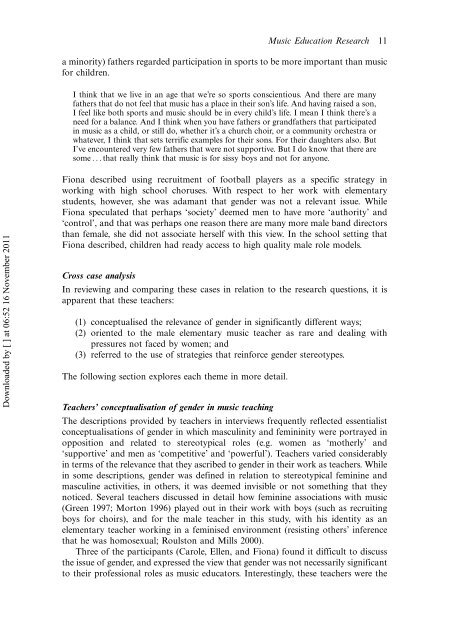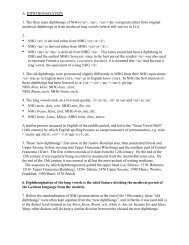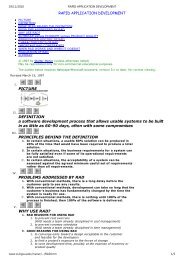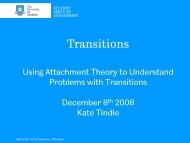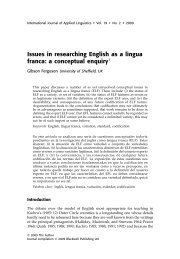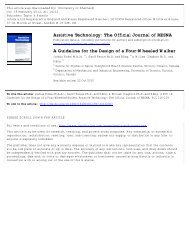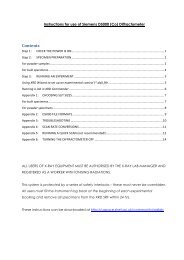Music teachers' constructions of gender in elementary education
Music teachers' constructions of gender in elementary education
Music teachers' constructions of gender in elementary education
Create successful ePaper yourself
Turn your PDF publications into a flip-book with our unique Google optimized e-Paper software.
Downloaded by [ ] at 06:52 16 November 2011<br />
a m<strong>in</strong>ority) fathers regarded participation <strong>in</strong> sports to be more important than music<br />
for children.<br />
I th<strong>in</strong>k that we live <strong>in</strong> an age that we’re so sports conscientious. And there are many<br />
fathers that do not feel that music has a place <strong>in</strong> their son’s life. And hav<strong>in</strong>g raised a son,<br />
I feel like both sports and music should be <strong>in</strong> every child’s life. I mean I th<strong>in</strong>k there’s a<br />
need for a balance. And I th<strong>in</strong>k when you have fathers or grandfathers that participated<br />
<strong>in</strong> music as a child, or still do, whether it’s a church choir, or a community orchestra or<br />
whatever, I th<strong>in</strong>k that sets terrific examples for their sons. For their daughters also. But<br />
I’ve encountered very few fathers that were not supportive. But I do know that there are<br />
some ...that really th<strong>in</strong>k that music is for sissy boys and not for anyone.<br />
Fiona described us<strong>in</strong>g recruitment <strong>of</strong> football players as a specific strategy <strong>in</strong><br />
work<strong>in</strong>g with high school choruses. With respect to her work with <strong>elementary</strong><br />
students, however, she was adamant that <strong>gender</strong> was not a relevant issue. While<br />
Fiona speculated that perhaps ‘society’ deemed men to have more ‘authority’ and<br />
‘control’, and that was perhaps one reason there are many more male band directors<br />
than female, she did not associate herself with this view. In the school sett<strong>in</strong>g that<br />
Fiona described, children had ready access to high quality male role models.<br />
Cross case analysis<br />
In review<strong>in</strong>g and compar<strong>in</strong>g these cases <strong>in</strong> relation to the research questions, it is<br />
apparent that these teachers:<br />
(1) conceptualised the relevance <strong>of</strong> <strong>gender</strong> <strong>in</strong> significantly different ways;<br />
(2) oriented to the male <strong>elementary</strong> music teacher as rare and deal<strong>in</strong>g with<br />
pressures not faced by women; and<br />
(3) referred to the use <strong>of</strong> strategies that re<strong>in</strong>force <strong>gender</strong> stereotypes.<br />
The follow<strong>in</strong>g section explores each theme <strong>in</strong> more detail.<br />
<strong>Music</strong> Education Research 11<br />
Teachers’ conceptualisation <strong>of</strong> <strong>gender</strong> <strong>in</strong> music teach<strong>in</strong>g<br />
The descriptions provided by teachers <strong>in</strong> <strong>in</strong>terviews frequently reflected essentialist<br />
conceptualisations <strong>of</strong> <strong>gender</strong> <strong>in</strong> which mascul<strong>in</strong>ity and fem<strong>in</strong><strong>in</strong>ity were portrayed <strong>in</strong><br />
opposition and related to stereotypical roles (e.g. women as ‘motherly’ and<br />
‘supportive’ and men as ‘competitive’ and ‘powerful’). Teachers varied considerably<br />
<strong>in</strong> terms <strong>of</strong> the relevance that they ascribed to <strong>gender</strong> <strong>in</strong> their work as teachers. While<br />
<strong>in</strong> some descriptions, <strong>gender</strong> was def<strong>in</strong>ed <strong>in</strong> relation to stereotypical fem<strong>in</strong><strong>in</strong>e and<br />
mascul<strong>in</strong>e activities, <strong>in</strong> others, it was deemed <strong>in</strong>visible or not someth<strong>in</strong>g that they<br />
noticed. Several teachers discussed <strong>in</strong> detail how fem<strong>in</strong><strong>in</strong>e associations with music<br />
(Green 1997; Morton 1996) played out <strong>in</strong> their work with boys (such as recruit<strong>in</strong>g<br />
boys for choirs), and for the male teacher <strong>in</strong> this study, with his identity as an<br />
<strong>elementary</strong> teacher work<strong>in</strong>g <strong>in</strong> a fem<strong>in</strong>ised environment (resist<strong>in</strong>g others’ <strong>in</strong>ference<br />
that he was homosexual; Roulston and Mills 2000).<br />
Three <strong>of</strong> the participants (Carole, Ellen, and Fiona) found it difficult to discuss<br />
the issue <strong>of</strong> <strong>gender</strong>, and expressed the view that <strong>gender</strong> was not necessarily significant<br />
to their pr<strong>of</strong>essional roles as music educators. Interest<strong>in</strong>gly, these teachers were the


